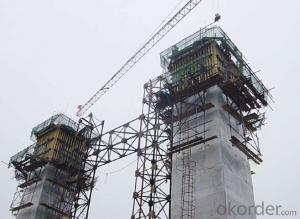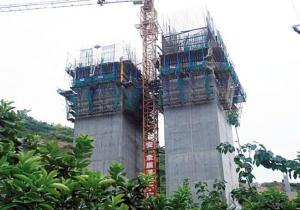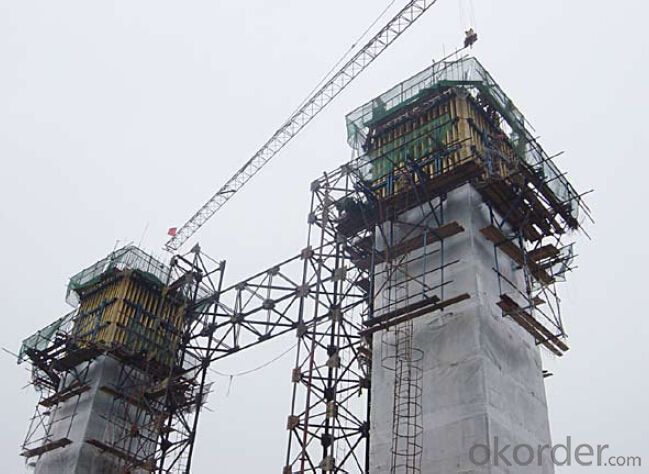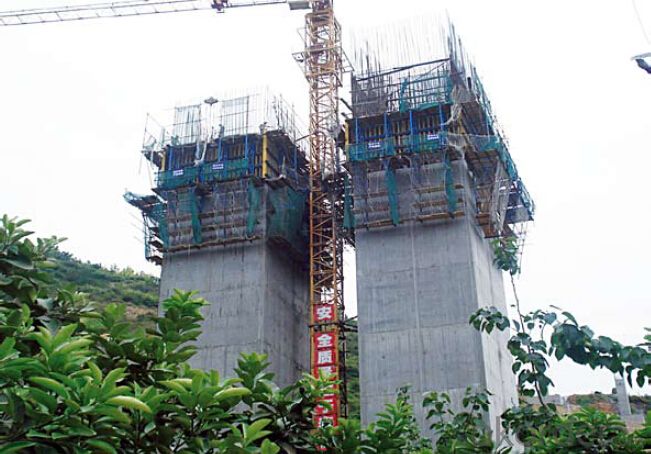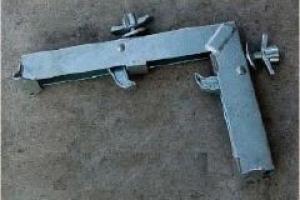Climbing Bracket for Formwork and Scaffolding Systems
- Loading Port:
- Tianjin
- Payment Terms:
- TT OR LC
- Min Order Qty:
- 50 m²
- Supply Capability:
- 1000 m²/month
OKorder Service Pledge
OKorder Financial Service
You Might Also Like
Climbing Bracket CB240 & CB210
They are framework brackets for supporting large-area wall formwork.
Typical applications for the CB240&CB210 are pier and column/shear wall/core walll/ in the
building.
CB210 has smaller size than CB240, it will be cost effective in some condition.
Characteristics:
◆ High bearing capacity
The high loading capacity of the brackets allow very large scaffold units. This saves the number
anchor points required as well as reducing climbing times.
◆ Simple moving procedure by crane
Through the strong connection of formwork together with the climbing scaffold, both can be moved
as a single climbing unit by crane. Thus valuable time-savings can be achieved.
◆ Fast striking process without a crane
With the retrusive set, large formwork elements can also be retracted quickly and a minimum of
effort.
◆ Safe with work platform
The platforms have assembled firmly with bracket and will be climbing together, without scaffolding
but can work safely in spite of your high location.
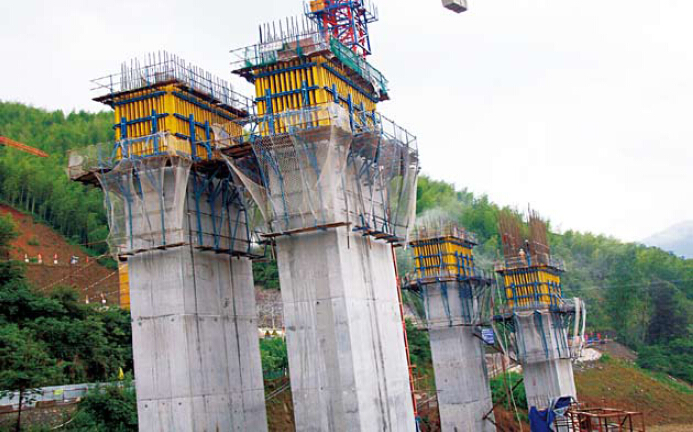
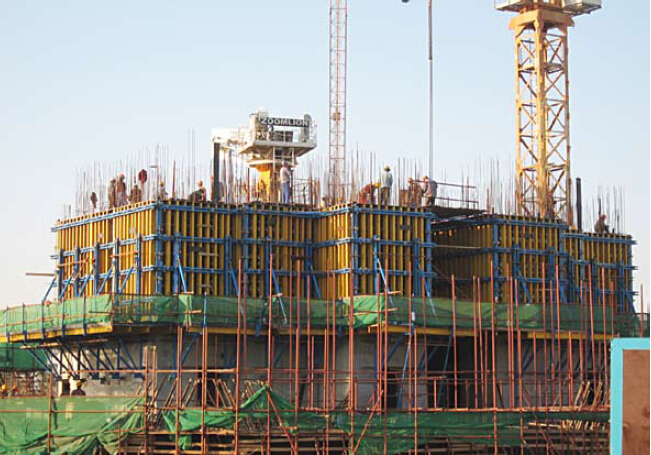
- Q: What are the different types of concrete finishes achievable with steel formwork?
- There are several types of concrete finishes that can be achieved with steel formwork, each offering a unique aesthetic and functional appeal. 1. Smooth Finish: Steel formwork can create a smooth finish on the concrete surface, which is often desired for applications such as walls, floors, and countertops. This finish provides a sleek and polished look and is achieved by using high-quality formwork materials and meticulous installation techniques. 2. Textured Finish: Steel formwork allows for various textured finishes to be achieved on the concrete surface. These textures can range from subtle patterns to more pronounced designs, offering visual interest and enhancing the overall appearance of the concrete. Textured finishes are commonly used in architectural applications to create a visually appealing and distinctive look. 3. Exposed Aggregate Finish: With steel formwork, it is possible to achieve an exposed aggregate finish on the concrete surface. This finish involves removing the top layer of the concrete to expose the aggregates, such as stones or pebbles, embedded within. Exposed aggregate finishes are popular for driveways, walkways, and decorative concrete applications, as they provide a natural and textured appearance. 4. Stamped Finish: Steel formwork can be used to create stamped finishes on the concrete surface, mimicking the appearance of materials like brick, tile, or natural stone. This technique involves pressing molds or stamps onto the concrete before it fully sets, leaving behind imprints that resemble the desired pattern. Stamped finishes are commonly used for patios, pool decks, and other outdoor areas, as they offer a cost-effective alternative to natural materials. 5. Acid Stain Finish: Steel formwork can also be utilized to achieve an acid stain finish on the concrete surface. Acid staining involves applying a chemical solution that reacts with the concrete, creating unique and translucent colors. This finish is often used in commercial and residential spaces where a more rustic and earthy look is desired, as it can enhance the natural variation and character of the concrete. In summary, steel formwork allows for a wide range of concrete finishes to be achieved, including smooth, textured, exposed aggregate, stamped, and acid stain finishes. Each finish offers its own visual and functional benefits, allowing designers and architects to create customized and appealing concrete surfaces for various applications.
- Q: How does steel formwork handle concrete surface blemishes?
- Steel formwork is a popular choice for construction projects due to its durability and strength. When it comes to handling concrete surface blemishes, steel formwork offers several advantages. Firstly, the smooth and rigid surface of steel formwork helps minimize the occurrence of surface blemishes on the concrete. Unlike other formwork materials such as timber, steel does not warp or deform easily, ensuring a consistent and even surface for the concrete to be poured onto. This reduces the chances of surface imperfections like air pockets, formwork marks, or uneven textures. Moreover, steel formwork allows for precise control over the concrete pouring process. The steel panels are manufactured with high precision, ensuring accurate dimensions and alignment. This precision, coupled with the tight joints and connections between the panels, minimizes the likelihood of concrete seepage or leakage, which can lead to surface blemishes such as honeycombing or efflorescence. Additionally, steel formwork can be easily cleaned and maintained, which further contributes to preventing or handling concrete surface blemishes. The smooth surface of steel allows for easy removal of any excess concrete or debris that might accumulate during the pouring process. This prevents the formation of unwanted blemishes and preserves the quality of the concrete surface. In cases where concrete surface blemishes do occur, steel formwork offers the advantage of being reusable. Unlike other formwork materials that may need to be discarded after a single use, steel formwork can be easily cleaned, repaired, and reused for multiple projects. This allows for more control over the quality of the formwork, reducing the risk of surface blemishes in subsequent concrete pours. In conclusion, steel formwork handles concrete surface blemishes effectively by providing a smooth and rigid surface, precise control over the pouring process, easy maintenance and cleaning, and reusability. These features contribute to achieving a high-quality concrete surface with minimal blemishes, ensuring a visually appealing and structurally sound end result.
- Q: Is steel formwork suitable for projects with high concrete pressure?
- Indeed, steel formwork proves to be a suitable choice for projects that involve high concrete pressure. Renowned for its robustness and durability, steel formwork possesses the ability to withstand the immense pressure exerted by the wet concrete during both pouring and curing stages. It effectively bears the weight and pressure of the concrete, preventing any deformation or collapse, thus ensuring the structure's stability and integrity throughout the construction process. Furthermore, steel formwork guarantees a smooth and uniform surface finish for the concrete, which is crucial for projects that demand top-notch quality. Moreover, its reusability feature makes it a cost-effective option for projects that entail high concrete pressure.
- Q: Can steel formwork be used for underground construction projects?
- Underground construction projects can indeed utilize steel formwork. Steel formwork proves to be a versatile and enduring option for erecting different types of structures, even those situated below ground level. It offers a robust and firm support system capable of withstanding the pressures and loads associated with underground construction. When it comes to constructing underground projects like tunnels, basements, or subways, steel formwork presents several advantages. Firstly, it boasts a high load-bearing capacity and structural integrity, making it suitable for enduring the weight and pressure exerted by the surrounding soil or water. This ensures the safety and stability of the structure being erected. Furthermore, steel formwork exhibits resistance to corrosion, a crucial attribute in underground construction where exposure to water, humidity, and other corrosive elements is prevalent. This corrosion resistance guarantees the longevity and durability of the formwork, minimizing maintenance needs and extending the lifespan of the structure. Moreover, steel formwork offers design flexibility and can be easily tailored to meet specific project requirements. It can be fabricated into various shapes and sizes, enabling the construction of intricate underground structures. The modular nature of steel formwork also facilitates effortless assembly, disassembly, and reusability, proving advantageous for projects that necessitate frequent formwork repositioning. In conclusion, steel formwork proves to be a suitable choice for underground construction projects due to its strength, durability, corrosion resistance, and design flexibility. It provides a dependable and efficient solution for erecting underground structures, ensuring their safety and longevity.
- Q: Can steel formwork be used for both residential and commercial construction projects?
- Yes, steel formwork can be used for both residential and commercial construction projects. Steel formwork is versatile and durable, making it suitable for various types of construction projects. It offers high strength and stability, allowing for efficient and precise construction of both residential and commercial structures.
- Q: How does steel formwork contribute to the overall sustainability of a construction project?
- There are several ways in which steel formwork contributes to the overall sustainability of a construction project. To begin with, steel formwork is highly durable and can be reused multiple times. This means that less waste is generated during the construction process, unlike traditional timber formwork which is typically discarded after only a few uses. By reducing waste, steel formwork helps conserve natural resources and decreases the environmental impact of the construction project. Furthermore, steel formwork is renowned for its strength and stability, enabling the construction of more robust structures. Consequently, buildings constructed using steel formwork are likely to have a longer lifespan, reducing the need for frequent repairs or reconstruction. The longevity of steel formwork contributes to the overall sustainability of a construction project by minimizing the resources and energy required for maintenance and renovation over time. In addition, steel formwork allows for faster construction as it can be easily assembled and disassembled. The efficiency and speed of steel formwork result in shorter construction periods, which in turn reduces the energy consumption and carbon emissions associated with construction activities. This is especially crucial in today's fast-paced construction industry, where reducing time on site is a key factor in achieving sustainable development goals. Moreover, steel formwork provides a higher quality finish to concrete structures, which can enhance the overall energy efficiency of a building. A smooth and precise finish achieved through steel formwork can reduce the need for additional insulation or cladding, thereby decreasing the energy required for heating or cooling the building. This not only benefits the environment but also improves the energy efficiency and comfort of the occupants. In conclusion, steel formwork contributes to the overall sustainability of a construction project by reducing waste, increasing durability, shortening construction time, and improving energy efficiency. By opting for steel formwork, construction projects can adopt a more sustainable and environmentally friendly approach, benefiting both the immediate project and the long-term impact on our planet.
- Q: What are the considerations when designing steel formwork for slabs with openings?
- When designing steel formwork for slabs with openings, several important considerations need to be taken into account. These include: 1. Load-bearing capacity: The formwork must be able to support the weight of the concrete, as well as any additional loads that may be placed on it during construction or use. The formwork should be designed to withstand these loads without experiencing excessive deflection or failure. 2. Durability: Steel formwork should be designed to withstand the harsh conditions of construction sites, including exposure to moisture, chemicals, and physical impact. The material chosen should be resistant to corrosion and have a high strength-to-weight ratio. 3. Flexibility and adjustability: Since slabs with openings often have irregular shapes and sizes, the formwork should be designed to be flexible and adjustable. This allows for easy customization and ensures a precise fit for the openings. 4. Support for reinforcement: The formwork should provide adequate support for the reinforcement bars or mesh used within the slab. It should be designed to accommodate the placement and spacing of these reinforcements, ensuring proper concrete cover and structural integrity. 5. Ease of assembly and disassembly: The formwork system should be designed for easy assembly and disassembly, as it needs to be repeatedly used for multiple slabs with openings. The components should be lightweight and easily maneuverable, allowing for efficient construction and reduced labor costs. 6. Safety: Safety is of utmost importance in the design of steel formwork. The formwork should be designed to prevent accidents, such as slipping or collapsing, during assembly, concrete pouring, and removal. Adequate safety measures, such as guardrails and non-slip surfaces, should be incorporated into the design. 7. Cost-effectiveness: The design should aim to minimize material and labor costs while still ensuring the required strength and durability. Efficient use of materials and standardization of components can help reduce overall costs. 8. Compatibility with other construction systems: The formwork should be compatible with other construction systems, such as scaffolding or shoring, to ensure proper integration and coordination during the construction process. By considering these factors, designers can create steel formwork systems that are safe, durable, cost-effective, and efficient for slabs with openings.
- Q: Can steel formwork be used for both temporary and permanent structures?
- Indeed, steel formwork serves as a practical option for both temporary and permanent structures. With its versatility and durability, steel formwork proves capable of withstanding high pressures, rendering it suitable for a range of construction projects. In the case of temporary structures, such as construction sites or temporary shelters, steel formwork presents an expedient and effective solution due to its easy assembly and disassembly. Furthermore, it finds utmost suitability in permanent structures such as bridges, high-rise buildings, or industrial facilities, where strength and durability are of utmost importance. Moreover, steel formwork's reusability adds to its appeal, rendering it a cost-effective choice for temporary and permanent construction endeavors alike.
- Q: What are the different accessories required for steel formwork maintenance?
- Some of the different accessories required for steel formwork maintenance include formwork release agents, cleaning solutions, wire brushes, repair materials such as epoxy or cementitious grout, lubricants for hinges and pins, and protective coatings for corrosion prevention. Additionally, tools such as hammers, wrenches, and pliers may be needed for minor repairs or adjustments.
- Q: Can steel formwork be custom-made?
- Yes, steel formwork can be custom-made to suit specific project requirements and dimensions. The flexibility of steel allows for customization in terms of shape, size, and design, making it a popular choice for construction projects that require unique or complex formwork solutions.
Send your message to us
Climbing Bracket for Formwork and Scaffolding Systems
- Loading Port:
- Tianjin
- Payment Terms:
- TT OR LC
- Min Order Qty:
- 50 m²
- Supply Capability:
- 1000 m²/month
OKorder Service Pledge
OKorder Financial Service
Similar products
Hot products
Hot Searches
